FILLING OF CAVITIES 1&5 CLASS BY BLACK PHANTOM


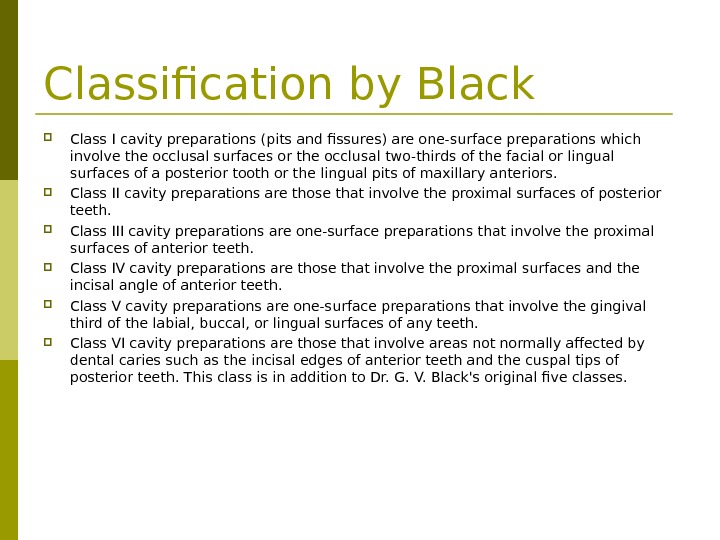
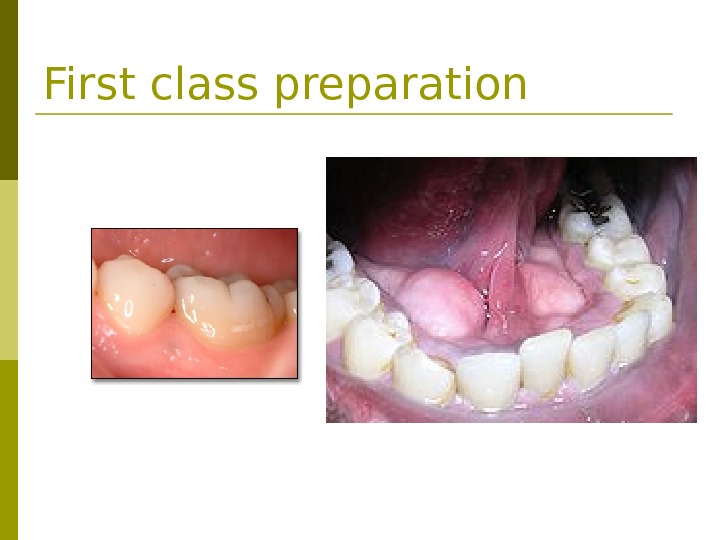
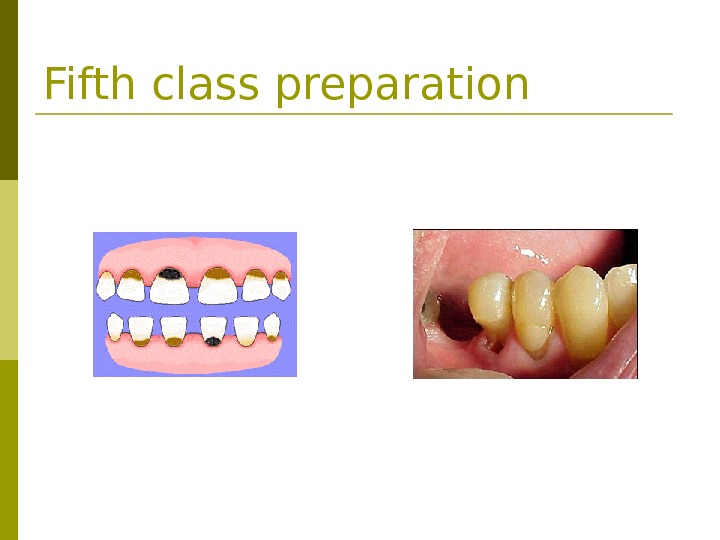
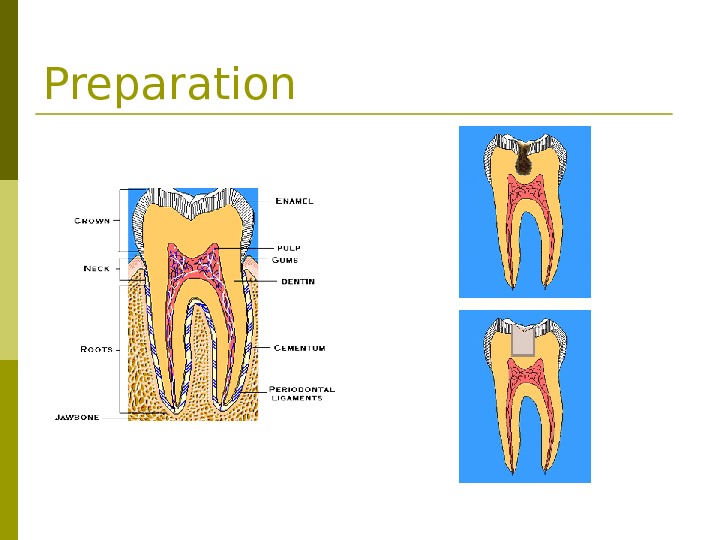
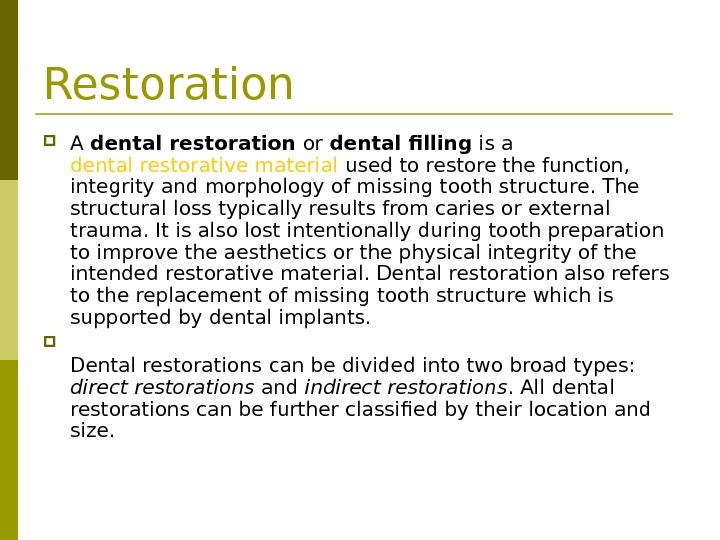
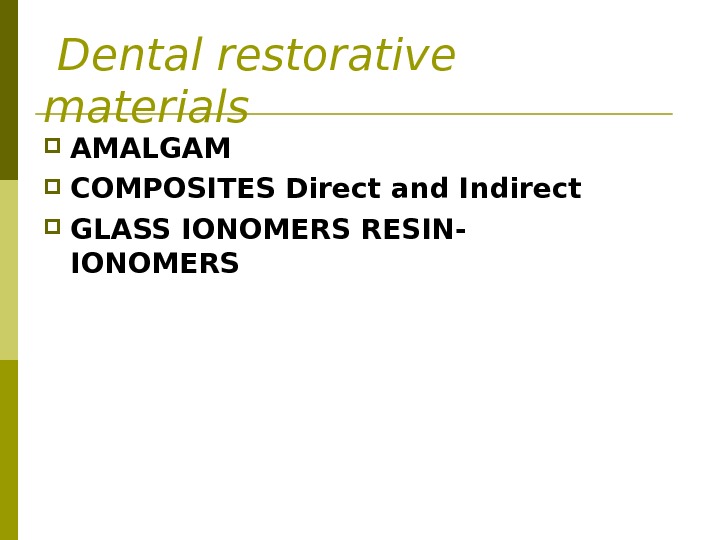
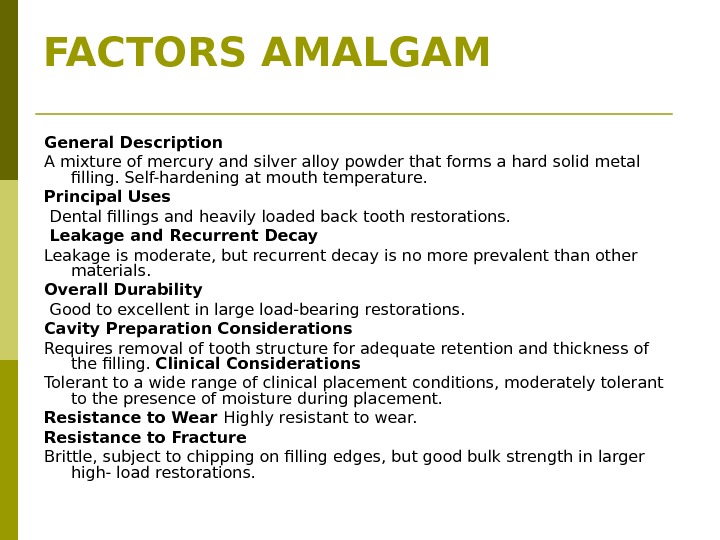
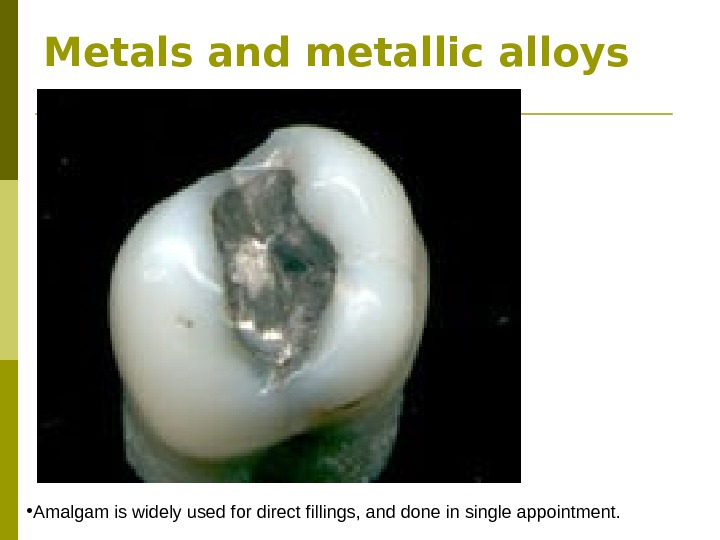
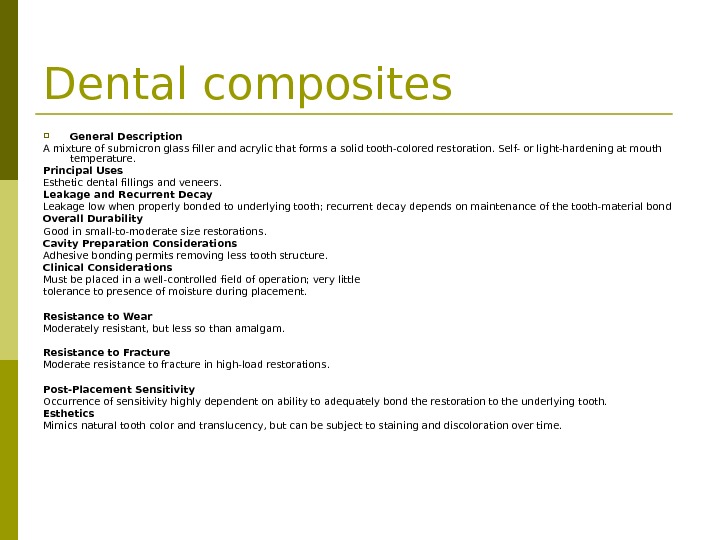
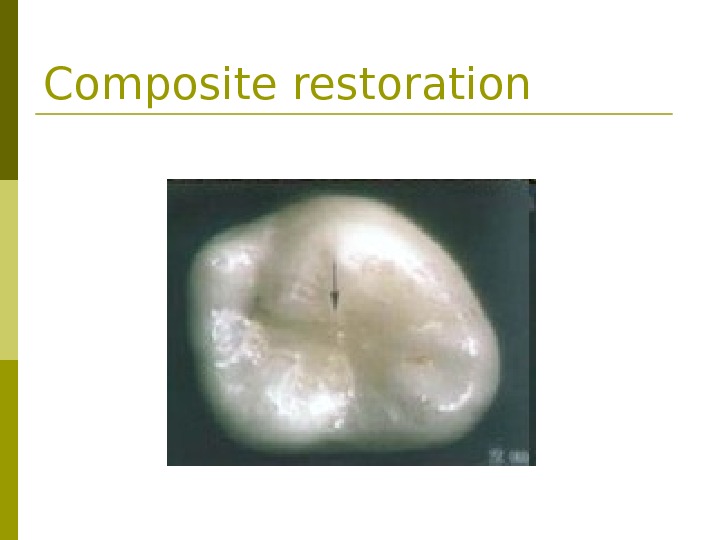
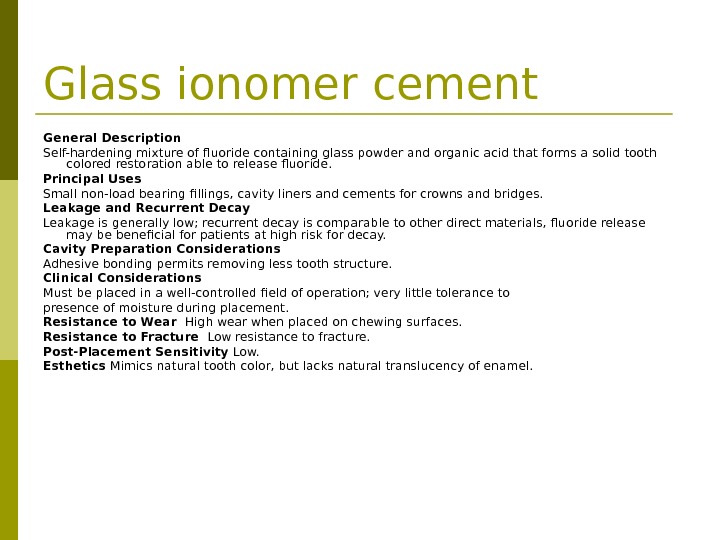
- Размер: 279.5 Кб
- Количество слайдов: 12
Описание презентации FILLING OF CAVITIES 1&5 CLASS BY BLACK PHANTOM по слайдам
 FILLING OF CAVITIES 1&5 CLASS BY BLACK PHANTOM COURSE 4 SEMESTR
FILLING OF CAVITIES 1&5 CLASS BY BLACK PHANTOM COURSE 4 SEMESTR
 Classification by Black Class I cavity preparations (pits and fissures) are one-surface preparations which involve the occlusal surfaces or the occlusal two-thirds of the facial or lingual surfaces of a posterior tooth or the lingual pits of maxillary anteriors. Class II cavity preparations are those that involve the proximal surfaces of posterior teeth. Class III cavity preparations are one-surface preparations that involve the proximal surfaces of anterior teeth. Class IV cavity preparations are those that involve the proximal surfaces and the incisal angle of anterior teeth. Class V cavity preparations are one-surface preparations that involve the gingival third of the labial, buccal, or lingual surfaces of any teeth. Class VI cavity preparations are those that involve areas not normally affected by dental caries such as the incisal edges of anterior teeth and the cuspal tips of posterior teeth. This class is in addition to Dr. G. V. Black’s original five classes.
Classification by Black Class I cavity preparations (pits and fissures) are one-surface preparations which involve the occlusal surfaces or the occlusal two-thirds of the facial or lingual surfaces of a posterior tooth or the lingual pits of maxillary anteriors. Class II cavity preparations are those that involve the proximal surfaces of posterior teeth. Class III cavity preparations are one-surface preparations that involve the proximal surfaces of anterior teeth. Class IV cavity preparations are those that involve the proximal surfaces and the incisal angle of anterior teeth. Class V cavity preparations are one-surface preparations that involve the gingival third of the labial, buccal, or lingual surfaces of any teeth. Class VI cavity preparations are those that involve areas not normally affected by dental caries such as the incisal edges of anterior teeth and the cuspal tips of posterior teeth. This class is in addition to Dr. G. V. Black’s original five classes.
 First class preparation
First class preparation
 Fifth class preparation
Fifth class preparation
 Preparation
Preparation
 Restoration A dental restoration or dental filling is a dental restorative material used to restore the function, integrity and morphology of missing tooth structure. The structural loss typically results from caries or external trauma. It is also lost intentionally during tooth preparation to improve the aesthetics or the physical integrity of the intended restorative material. Dental restoration also refers to the replacement of missing tooth structure which is supported by dental implants. Dental restorations can be divided into two broad types: direct restorations and indirect restorations. All dental restorations can be further classified by their location and size.
Restoration A dental restoration or dental filling is a dental restorative material used to restore the function, integrity and morphology of missing tooth structure. The structural loss typically results from caries or external trauma. It is also lost intentionally during tooth preparation to improve the aesthetics or the physical integrity of the intended restorative material. Dental restoration also refers to the replacement of missing tooth structure which is supported by dental implants. Dental restorations can be divided into two broad types: direct restorations and indirect restorations. All dental restorations can be further classified by their location and size.
 Dental restorative materials AMALGAM COMPOSITES Direct and Indirect GLASS IONOMERS RESIN- IONOMERS
Dental restorative materials AMALGAM COMPOSITES Direct and Indirect GLASS IONOMERS RESIN- IONOMERS
 FACTORS AMALGAM General Description A mixture of mercury and silver alloy powder that forms a hard solid metal filling. Self-hardening at mouth temperature. Principal Uses Dental fillings and heavily loaded back tooth restorations. Leakage and Recurrent Decay Leakage is moderate, but recurrent decay is no more prevalent than other materials. Overall Durability Good to excellent in large load-bearing restorations. Cavity Preparation Considerations Requires removal of tooth structure for adequate retention and thickness of the filling. Clinical Considerations Tolerant to a wide range of clinical placement conditions, moderately tolerant to the presence of moisture during placement. Resistance to Wear Highly resistant to wear. Resistance to Fracture Brittle, subject to chipping on filling edges, but good bulk strength in larger high- load restorations.
FACTORS AMALGAM General Description A mixture of mercury and silver alloy powder that forms a hard solid metal filling. Self-hardening at mouth temperature. Principal Uses Dental fillings and heavily loaded back tooth restorations. Leakage and Recurrent Decay Leakage is moderate, but recurrent decay is no more prevalent than other materials. Overall Durability Good to excellent in large load-bearing restorations. Cavity Preparation Considerations Requires removal of tooth structure for adequate retention and thickness of the filling. Clinical Considerations Tolerant to a wide range of clinical placement conditions, moderately tolerant to the presence of moisture during placement. Resistance to Wear Highly resistant to wear. Resistance to Fracture Brittle, subject to chipping on filling edges, but good bulk strength in larger high- load restorations.
 Metals and metallic alloys • Amalgam is widely used for direct fillings, and done in single appointment.
Metals and metallic alloys • Amalgam is widely used for direct fillings, and done in single appointment.
 Dental composites General Description A mixture of submicron glass filler and acrylic that forms a solid tooth-colored restoration. Self- or light-hardening at mouth temperature. Principal Uses Esthetic dental fillings and veneers. Leakage and Recurrent Decay Leakage low when properly bonded to underlying tooth; recurrent decay depends on maintenance of the tooth-material bond Overall Durability Good in small-to-moderate size restorations. Cavity Preparation Considerations Adhesive bonding permits removing less tooth structure. Clinical Considerations Must be placed in a well-controlled field of operation; very little tolerance to presence of moisture during placement. Resistance to Wear Moderately resistant, but less so than amalgam. Resistance to Fracture Moderate resistance to fracture in high-load restorations. Post-Placement Sensitivity Occurrence of sensitivity highly dependent on ability to adequately bond the restoration to the underlying tooth. Esthetics Mimics natural tooth color and translucency, but can be subject to staining and discoloration over time.
Dental composites General Description A mixture of submicron glass filler and acrylic that forms a solid tooth-colored restoration. Self- or light-hardening at mouth temperature. Principal Uses Esthetic dental fillings and veneers. Leakage and Recurrent Decay Leakage low when properly bonded to underlying tooth; recurrent decay depends on maintenance of the tooth-material bond Overall Durability Good in small-to-moderate size restorations. Cavity Preparation Considerations Adhesive bonding permits removing less tooth structure. Clinical Considerations Must be placed in a well-controlled field of operation; very little tolerance to presence of moisture during placement. Resistance to Wear Moderately resistant, but less so than amalgam. Resistance to Fracture Moderate resistance to fracture in high-load restorations. Post-Placement Sensitivity Occurrence of sensitivity highly dependent on ability to adequately bond the restoration to the underlying tooth. Esthetics Mimics natural tooth color and translucency, but can be subject to staining and discoloration over time.
 Composite restoration
Composite restoration
 Glass ionomer cement General Description Self-hardening mixture of fluoride containing glass powder and organic acid that forms a solid tooth colored restoration able to release fluoride. Principal Uses Small non-load bearing fillings, cavity liners and cements for crowns and bridges. Leakage and Recurrent Decay Leakage is generally low; recurrent decay is comparable to other direct materials, fluoride release may be beneficial for patients at high risk for decay. Cavity Preparation Considerations Adhesive bonding permits removing less tooth structure. Clinical Considerations Must be placed in a well-controlled field of operation; very little tolerance to presence of moisture during placement. Resistance to Wear High wear when placed on chewing surfaces. Resistance to Fracture Low resistance to fracture. Post-Placement Sensitivity Low. Esthetics Mimics natural tooth color, but lacks natural translucency of enamel.
Glass ionomer cement General Description Self-hardening mixture of fluoride containing glass powder and organic acid that forms a solid tooth colored restoration able to release fluoride. Principal Uses Small non-load bearing fillings, cavity liners and cements for crowns and bridges. Leakage and Recurrent Decay Leakage is generally low; recurrent decay is comparable to other direct materials, fluoride release may be beneficial for patients at high risk for decay. Cavity Preparation Considerations Adhesive bonding permits removing less tooth structure. Clinical Considerations Must be placed in a well-controlled field of operation; very little tolerance to presence of moisture during placement. Resistance to Wear High wear when placed on chewing surfaces. Resistance to Fracture Low resistance to fracture. Post-Placement Sensitivity Low. Esthetics Mimics natural tooth color, but lacks natural translucency of enamel.

